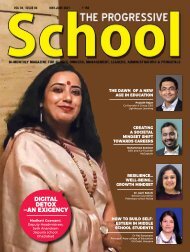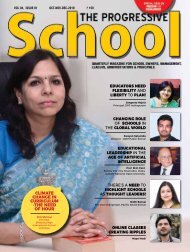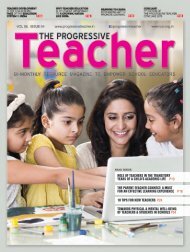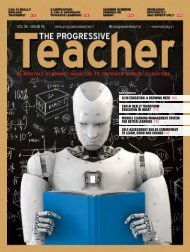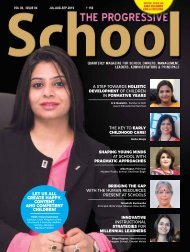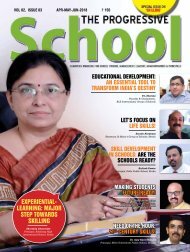The Progressive Teacher Vol 04 Issue 03
This issue of The Progressive Teacher focuses on "New Trends in Education ". In this edition, articles explore contemporary trends to enhance interactive learning amongst students.
This issue of The Progressive Teacher focuses on "New Trends in Education ". In this edition, articles explore contemporary trends to enhance interactive learning amongst students.
You also want an ePaper? Increase the reach of your titles
YUMPU automatically turns print PDFs into web optimized ePapers that Google loves.
worksheet<br />
Max Marks: 20<br />
Kingdoms, Kings and an Early Republic<br />
Tick ( ) the correct answer<br />
1. By 600 BC, there were __________ mahajanapadas.<br />
a. 16 c. 13<br />
b. 12 d. 15<br />
2. <strong>The</strong> capital of the republic of Vajji was<br />
_____________<br />
a. Champa c. Vaishali<br />
b. Bodhgaya d. Rajgriha<br />
3. Out of the 16 Mahajanapadas, which was the most<br />
powerful?<br />
a. Champa c. Magadha<br />
b. Bharuch d. Rajagriha<br />
4. Which of the following features of tribal rajas made<br />
them different from the rajas of the Kingdoms?<br />
a. No army c. Both a and b<br />
b. No palaces d. Pompous titles<br />
5. What became a major form of power?<br />
a. Coins c. Cattle<br />
b. Buildings d. Territory<br />
6. <strong>The</strong> rajas performed which of the following yajnas<br />
to strengthen their position?<br />
a. Rajsuya Yajna c. Rajeshwara Yajna<br />
b. Ashwamedha Yajna d. Bandarka Yajna<br />
7. <strong>The</strong> word Janapada means<br />
a. People’s belongings<br />
d. Land where people settled down<br />
c. People’s territory<br />
d. People’s power<br />
Class VI: history<br />
9. Which of the following is not a characteristic of a<br />
Mahajanpadas?<br />
a. Capital city<br />
b. Construction of wall around the periphery<br />
c. Peaceful life<br />
d. Walls made of wood, stone or bricks.<br />
10. Which of the following was not a tax collected by<br />
the rajas of those times?<br />
a. Taxes on crops<br />
b. Taxes on hunters and gatherers<br />
c. Taxes on trade<br />
d. Service tax<br />
State whether the following statements are true or false:<br />
11. Monarchy is rule by ministers.<br />
12. <strong>The</strong> Buddha belonged to the Lichchavi clan.<br />
13. Magadha became very powerful due to large<br />
deposits of iron ore.<br />
14. We have literary and archaeological sources<br />
for the study of the Mahajanapadas.<br />
15. <strong>The</strong> religion of the Later Aryans was Jainism.<br />
16. Ajatshatru and Bindusara were the powerful<br />
rulers of Magadha.<br />
17. Fill in the boxes given below with the advantages<br />
that Magadha had over other kingdoms:<br />
Advantages Magadha enjoyed<br />
over other kingdoms<br />
8. Which of the following is not a prominent monarchy<br />
of Mahajanapadas?<br />
a. Kosala c. Vatsa<br />
b. Maurya d. Magadha<br />
A: B: C: D:<br />
<strong>The</strong> Changing World of Visual Arts<br />
Answer Key - Class VIII: History<br />
1. c<br />
2. a<br />
3. a<br />
4. a<br />
5. c<br />
6. d<br />
7. d<br />
8. b<br />
9. a<br />
10. d<br />
11. c<br />
12. c<br />
13. b<br />
14. b<br />
15. T<br />
16. T<br />
17. T<br />
18. Any Three<br />
a) Landscape<br />
b) Portrait<br />
Painting<br />
c) Historical<br />
Paintings<br />
d) Picturesque<br />
Painting<br />
<strong>The</strong> National Movement: 1885-1919<br />
1. b 2. c<br />
3. d 4. b<br />
5. a 6. d<br />
7. c 8. a<br />
9. b 10. b<br />
11. 1917<br />
12. Bombay,1985<br />
13. 1905<br />
14. Surat, Lucknow<br />
15. 1919<br />
16. Any Three<br />
a) Elected<br />
representatives in the<br />
provincial and central<br />
legislative councils<br />
b) Recruit Indians<br />
for high government<br />
posts and holding the<br />
Indian Civil Service<br />
examinations in India<br />
c) Reduction of military<br />
expenditure<br />
d) Changes in<br />
government’s economic<br />
polices to encourage<br />
growth of Indian<br />
industries<br />
e) Promoting the spread<br />
of education<br />
f) Amendment of the<br />
Arms Act<br />
Answer Key - Class VIII: Geography<br />
Industry<br />
1. c<br />
2. d<br />
3. b<br />
4. d<br />
5. a<br />
6. c<br />
7. b<br />
8. d<br />
9. c<br />
10. b<br />
11. a<br />
12. c<br />
13. d<br />
14. b<br />
15. c<br />
16. a<br />
17. d<br />
18. b<br />
19. c<br />
20. c<br />
Human Resources<br />
1. b<br />
2. c<br />
3. d<br />
4. a<br />
5. c<br />
6. b<br />
7. d<br />
8. b<br />
9. c<br />
10. d<br />
11. a<br />
12. c<br />
13. d<br />
14. b<br />
15. c<br />
16. a<br />
17. d<br />
18. b<br />
19. c<br />
20. d<br />
Circles<br />
1. a<br />
2. b<br />
3. d<br />
4. c<br />
5. a<br />
6. d<br />
7. b<br />
8. d<br />
9. c<br />
10. c<br />
11. b<br />
12. d<br />
13. Nill<br />
14. 1<br />
15. 2<br />
16. Tangent<br />
17. Point of Contact<br />
18. Equal<br />
19. Perpendicular<br />
20. Infinite<br />
Answer Key - Class X: mathematics<br />
1. b<br />
1. d<br />
2. c<br />
2. b<br />
3. d<br />
3. d<br />
4. a<br />
4. a<br />
5. b<br />
6. c<br />
5. c<br />
7. d<br />
6. a<br />
8. c<br />
9. b<br />
7. d<br />
10. c<br />
8. b<br />
11. d<br />
12. e<br />
9. c<br />
13. f<br />
10. c<br />
14. b<br />
15. 90 O<br />
11. d<br />
16. 16:25<br />
12. a<br />
17. 150 O<br />
18. Area of Minor<br />
13. c<br />
Segment<br />
π<br />
19. cm<br />
8<br />
14. b<br />
20. 7 cm<br />
Constructions<br />
Areas Related to Circles<br />
Surface Areas and <strong>Vol</strong>umes<br />
1. b<br />
2. a<br />
3. d<br />
4. c<br />
5. d<br />
6. a<br />
7. c<br />
8. b<br />
9. b<br />
10. c<br />
11. b<br />
12. b<br />
13. d<br />
14. c<br />
15. f<br />
16. e<br />
17. h<br />
18. c<br />
19. a<br />
20. d<br />
28<br />
<strong>The</strong> <strong>Progressive</strong> <strong>Teacher</strong><br />
© DS Digital Private Limited I Photocopying permitted




